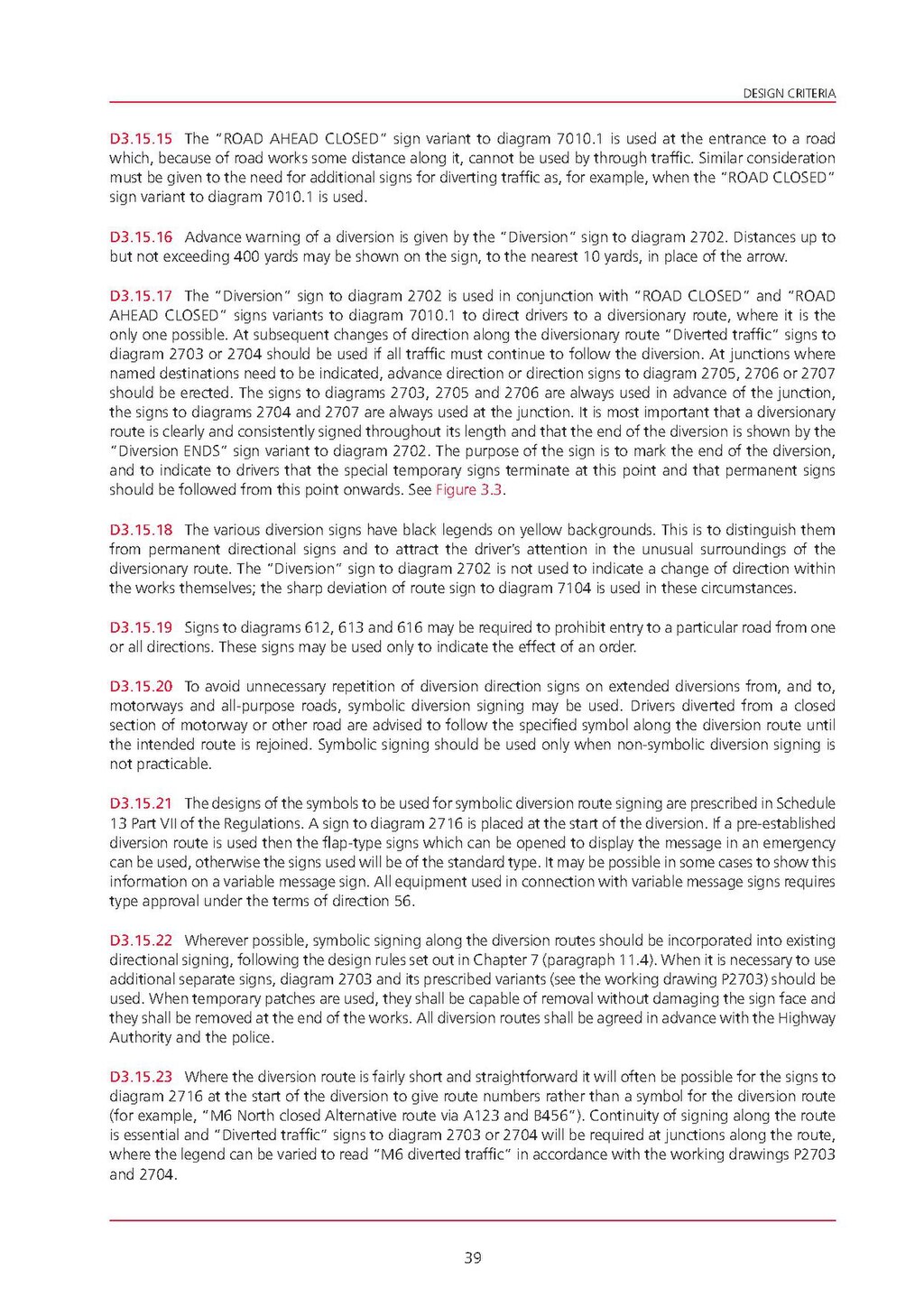D3.15.15 The "ROAD AHEAD CLOSED" sign variant to diagram 7010.1 is used at the entrance to a road which, because of road works some distance along it, cannot be used by through traffic. Similar consideration must be given to the need for additional signs for diverting traffic as, for example, when the "ROAD CLOSED" sign variant to diagram 7010.1 is used.
D3.15.16 Advance warning of a diversion is given by the "Diversion" sign to diagram 2702. Distances up to but not exceeding 400 yards may be shown on the sign, to the nearest 10 yards, in place of the arrow.
D3.15.17 The "Diversion" sign to diagram 2702 is used in conjunction with "ROAD CLOSED" and "ROAD AHEAD CLOSED" signs variants to diagram 7010.1 to direct drivers to a diversionary route, where it is the only one possible. At subsequent changes of direction along the diversionary route "Diverted traffic" signs to diagram 2703 or 2704 should be used if all traffic must continue to follow the diversion. At junctions where named destinations need to be indicated, advance direction or direction signs to diagram 2705, 2706 or 2707 should be erected. The signs to diagrams 2703, 2705 and 2706 are always used in advance of the junction, the signs to diagrams 2704 and 2707 are always used at the junction. It is most important that a diversionary route is clearly and consistently signed throughout its length and that the end of the diversion is shown by the "Diversion ENDS" sign variant to diagram 2702. The purpose of the sign is to mark the end of the diversion, and to indicate to drivers that the special temporary signs terminate at this point and that permanent signs should be followed from this point onwards. See Figure 3.3.
D3.15.18 The various diversion signs have black legends on yellow backgrounds. This is to distinguish them from permanent directional signs and to attract the driver's attention in the unusual surroundings of the diversionary route. The "Diversion" sign to diagram 2702 is not used to indicate a change of direction within the works themselves; the sharp deviation of route sign to diagram 7104 is used in these circumstances.
D3.15.19 Signs to diagrams 612, 613 and 616 may be required to prohibit entry to a particular road from one or all directions. These signs may be used only to indicate the effect of an order.
D3.15.20 To avoid unnecessary repetition of diversion direction signs on extended diversions from, and to, motorways and all-purpose roads, symbolic diversion signing may be used. Drivers diverted from a closed section of motorway or other road are advised to follow the specified symbol along the diversion route until the intended route is rejoined. Symbolic signing should be used only when non-symbolic diversion signing is not practicable.
D3.15.21 The designs of the symbols to be used for symbolic diversion route signing are prescribed in Schedule 13 Part VII of the Regulations. A sign to diagram 2716 is placed at the start of the diversion. If a pre-established diversion route is used then the flap-type signs which can be opened to display the message in an emergency can be used, otherwise the signs used will be of the standard type. It may be possible in some cases to show this information on a variable message sign. All equipment used in connection with variable message signs requires type approval under the terms of direction 56.
D3.15.22 Wherever possible, symbolic signing along the diversion routes should be incorporated into existing directional signing, following the design rules set out in Chapter 7 (paragraph 11.4). When it is necessary to use additional separate signs, diagram 2703 and its prescribed variants (see the working drawing P2703) should be used. When temporary patches are used, they shall be capable of removal without damaging the sign face and they shall be removed at the end of the works. All diversion routes shall be agreed in advance with the Highway Authority and the police.
D3.15.23 Where the diversion route is fairly short and straightforward it will often be possible for the signs to diagram 2716 at the start of the diversion to give route numbers rather than a symbol for the diversion route (for example, "M6 North closed Alternative route via A123 and B456"). Continuity of signing along the route is essential and "Diverted traffic" signs to diagram 2703 or 2704 will be required at junctions along the route, where the legend can be varied to read "M6 diverted traffic" in accordance with the working drawings P2703 and 2704.
39
